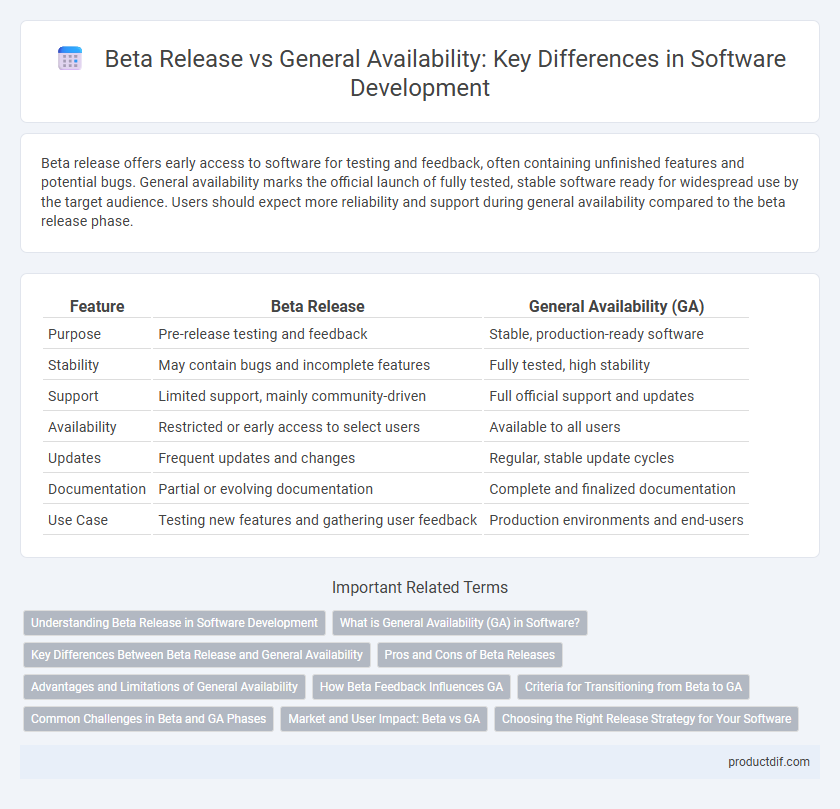Beta release offers early access to software for testing and feedback, often containing unfinished features and potential bugs. General availability marks the official launch of fully tested, stable software ready for widespread use by the target audience. Users should expect more reliability and support during general availability compared to the beta release phase.
Table of Comparison
| Feature | Beta Release | General Availability (GA) |
|---|---|---|
| Purpose | Pre-release testing and feedback | Stable, production-ready software |
| Stability | May contain bugs and incomplete features | Fully tested, high stability |
| Support | Limited support, mainly community-driven | Full official support and updates |
| Availability | Restricted or early access to select users | Available to all users |
| Updates | Frequent updates and changes | Regular, stable update cycles |
| Documentation | Partial or evolving documentation | Complete and finalized documentation |
| Use Case | Testing new features and gathering user feedback | Production environments and end-users |
Understanding Beta Release in Software Development
Beta release in software development refers to a pre-release version made available to a limited audience for testing and feedback before the general availability (GA) launch. It helps identify bugs, gather user experience data, and improve software stability by exposing the product to real-world conditions. This stage is crucial for refining features and ensuring the software meets quality standards prior to the final release.
What is General Availability (GA) in Software?
General Availability (GA) in software refers to the stage when a product is fully developed, tested, and deemed stable for release to all users, often accompanied by official support and documentation. This phase marks the transition from limited testing or beta releases to widespread distribution, ensuring reliability and compatibility across target environments. GA versions typically receive regular updates and maintenance, reflecting the software's readiness for production use in real-world scenarios.
Key Differences Between Beta Release and General Availability
Beta release serves as a preliminary version of software, providing early access to new features for testing and feedback, often containing bugs or incomplete functionality. General availability (GA) marks the official launch, signifying a stable, fully tested, and production-ready product intended for broad commercial use. The key differences lie in stability, target audience, and support level, with GA offering comprehensive customer support and performance assurances absent in beta versions.
Pros and Cons of Beta Releases
Beta releases offer early user feedback and bug identification, allowing developers to improve software quality before the general availability phase. However, beta versions may contain unresolved issues, leading to potential instability and limited feature completeness that can affect user experience. This phase helps balance innovation with risk, but businesses must communicate the software's developmental status clearly to manage user expectations effectively.
Advantages and Limitations of General Availability
General Availability (GA) marks the official release of software, offering full support, stability, and comprehensive documentation, ensuring reliability for production environments. GA versions typically undergo rigorous testing compared to Beta releases, reducing bugs and improving user experience but may lack the early feedback-driven features found in Beta. The limitation of GA lies in slower feature updates, as changes must pass stringent quality checks, potentially delaying innovative functionalities introduced in prior Beta versions.
How Beta Feedback Influences GA
Beta feedback plays a crucial role in shaping the General Availability (GA) release by identifying bugs, usability issues, and performance bottlenecks through real-world user interactions. Insights gathered from beta testers enable developers to prioritize fixes, optimize features, and enhance security before the final launch. This iterative process ensures the GA version delivers a more stable, user-friendly, and reliable software product.
Criteria for Transitioning from Beta to GA
Successful transition from Beta to General Availability (GA) requires meeting key criteria such as thorough testing completion, user feedback incorporation, and system stability validation. Performance metrics must demonstrate consistent reliability under real-world conditions, while critical bugs and security vulnerabilities need resolution prior to GA release. Compliance with defined feature requirements and scalability benchmarks ensures the software is production-ready and aligns with market expectations.
Common Challenges in Beta and GA Phases
Beta release often faces challenges like incomplete features, undiscovered bugs, and limited user feedback, which can impact overall software stability. During the general availability (GA) phase, issues shift towards scalability, performance optimization, and broader user adoption complexities. Both phases require robust monitoring, timely updates, and clear communication to ensure successful software deployment and user satisfaction.
Market and User Impact: Beta vs GA
Beta releases enable early access for select users to test new software features and provide critical feedback, helping identify bugs and usability issues before full launch. General Availability (GA) signifies a stable, fully tested product ready for wide market distribution, ensuring reliability and enhanced user trust. The transition from Beta to GA often results in increased adoption rates and customer satisfaction due to improved performance and comprehensive support.
Choosing the Right Release Strategy for Your Software
Selecting the correct release strategy hinges on understanding user engagement and feedback mechanisms, where beta releases offer critical testing environments to identify bugs and gather user insights before general availability. Beta releases enable iterative improvements and risk mitigation by exposing software to a limited audience, while general availability signifies a polished, stable product ready for widespread adoption. Prioritizing factors such as target audience readiness, feature completeness, and support infrastructure ensures optimal deployment and maximizes user satisfaction in the competitive software market.
Beta Release vs General Availability Infographic

 productdif.com
productdif.com